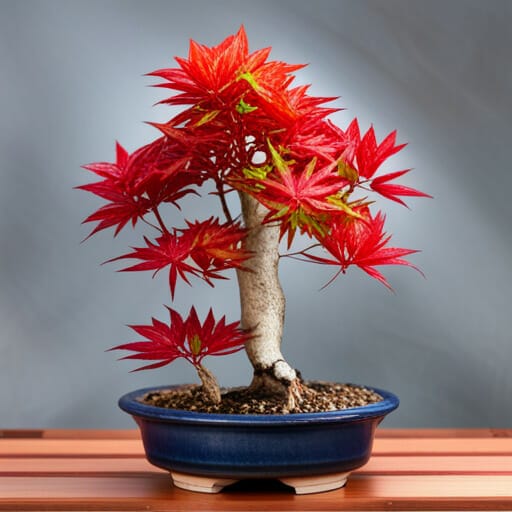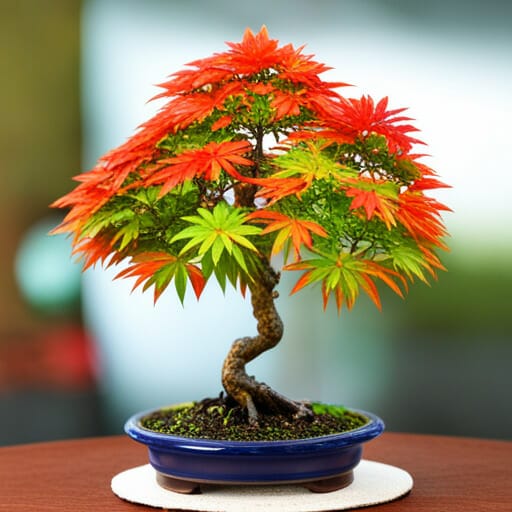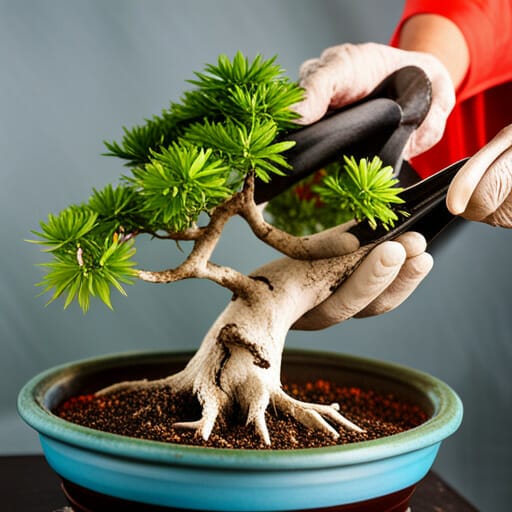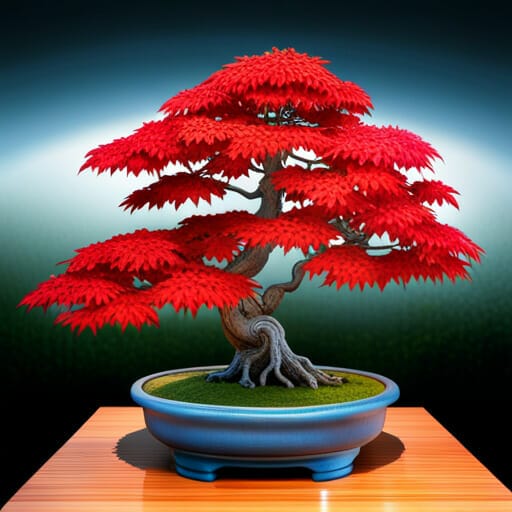Japanese maple bonsai, with its captivating beauty and diverse range of varieties, is a popular choice among bonsai enthusiasts. This art form showcases the intricate beauty of nature in miniature form. With over 50 varieties to choose from, each possessing its own unique characteristics, Japanese maple bonsai offers an enchanting array of options.
These bonsai trees display small size, round and smooth trunks, good ramification, small and delicate leaves, and stunning leaf colors. Their trunks develop a striped pattern as they age, adding to their visual appeal. The branches ramify finely, creating a dense and intricate structure. In the fall, the leaves undergo a breathtaking color change. Japanese maple bonsai trees also boast beautiful surface roots, known as nebari.
With proper cultivation and care, these exquisite trees can be shaped and maintained to showcase their full potential. Join us as we explore the beauty and wonder of Japanese maple bonsai, its varieties, characteristics, and more.
Contents
- 1 Quick Points
- 2 Varieties of Japanese Maple
- 3 Characteristics of Japanese Maple
- 4 Cultivation and Care Tips
- 5 Frequently Asked Questions
- 5.1 How long does it take for a Japanese maple bonsai to reach maturity?
- 5.2 Can Japanese maple bonsai tolerate full sun or do they require shade?
- 5.3 Are there any specific pests or diseases that commonly affect Japanese maple bonsai?
- 5.4 What is the best time of year to repot a Japanese maple bonsai?
- 5.5 Can Japanese maple bonsai be grown indoors or do they need to be kept outdoors?
Quick Points
- Japanese maple bonsai is a popular choice among bonsai enthusiasts, with over 50 varieties, each having unique characteristics.
- These bonsai have small size, round and smooth trunks, with good ramification and intricate branch structure.
- They have small and delicate leaves, with a breathtaking color change in the fall, and beautiful nebari (surface roots).
– The cultivation and care of Japanese maple bonsai involve pruning, defoliation, adequate sunlight, watering, fertilization, protection from extreme temperatures and pests, as well as branch wiring and shaping.
Varieties of Japanese Maple

There are approximately 50 known varieties of Japanese maple bonsai, including Kotohime, Kiyohime, Seigen, Shishigashira, Deshojo, Yamamomiji, and Yatsubusa, each with their own unique characteristics and aesthetic appeal.
Kotohime is highly regarded as the best Japanese maple bonsai variety due to its small leaves, dense foliage, and short internodes.
Deshojo stands out for its remarkable ability to change leaf color, adding visual interest to any bonsai collection.
Kiyohime features small and dense leaves, along with horizontal branches that create an elegant and balanced appearance.
Seigen showcases brilliant red new leaves, adding a vibrant burst of color.
Shishigashira is known for its curly and dense leaves, lending a unique texture to the bonsai.
Yamamomiji, native to Japan, offers strength and ease of training as a bonsai, and can be either Acer palmatum subsp. matsumurae or Acer amoenum var. matsumurae.
Lastly, Yatsubusa exhibits multiple layered foliages and beautiful leaf color, adding depth and visual interest to any bonsai display.
Learn More About Japanese Maple Bonsai Styles, Techniques, Symbolism, and Meaning
Characteristics of Japanese Maple

Renowned for their exquisite foliage and captivating transformation in autumn, the leaves of Japanese maple trees possess a delicate elegance that enchants observers throughout the seasons. These trees exhibit several characteristics that contribute to their beauty and desirability as bonsai specimens:
- Small and delicate leaves with saw-like edges create a sense of refinement and grace.
- The change in leaf color in the fall is exceptionally beautiful, ranging from vibrant reds and oranges to subtle shades of yellow and gold.
- The round and smooth trunks, with a distinct striped pattern as they age, add to the overall aesthetic appeal of the bonsai.
- Japanese maples have the ability to ramify their branches finely, creating a sense of intricacy and complexity in their overall structure.
- The presence of good surface roots, known as nebari, enhances the visual impact of the bonsai, giving it a sense of stability and maturity.
These characteristics, combined with the diverse range of Japanese maple varieties available, make them a popular choice for bonsai enthusiasts seeking to create visually striking and captivating miniature trees.
Cultivation and Care Tips

Cultivation and care of Japanese maple trees involve providing appropriate pruning and defoliation techniques to maintain their desired size and shape. These techniques allow bonsai enthusiasts to create and maintain the characteristic features of Japanese maple bonsai, such as small size, round and smooth trunks, good ramification, and delicate leaves. Proper care also includes providing adequate sunlight, watering, and fertilization to ensure the health and vigor of the trees. Additionally, it is important to protect the trees from extreme temperatures and pests. Bonsai enthusiasts can also enhance the beauty of Japanese maple bonsai by selectively wiring and shaping the branches to create an aesthetically pleasing composition. With proper care and attention, Japanese maple bonsai can thrive and bring joy to both the grower and those who appreciate these miniature works of art.
| Cultivation Tips | Care Tips |
|---|---|
| – Prune branches to maintain desired shape | – Provide adequate sunlight |
| – Defoliate to encourage ramification | – Water regularly, avoiding overwatering |
| – Protect from extreme temperatures | – Fertilize during the growing season |
| – Wire and shape branches for desired composition | – Protect from pests and diseases |
Frequently Asked Questions
How long does it take for a Japanese maple bonsai to reach maturity?
The time it takes for a Japanese maple bonsai to reach maturity can vary depending on factors such as care and growth conditions. However, on average, it may take several years or even decades for a bonsai tree to achieve full maturity and exhibit its desired characteristics.
Can Japanese maple bonsai tolerate full sun or do they require shade?
Japanese maple bonsai trees can tolerate full sun, but they generally prefer partial shade to protect their delicate leaves from scorching. Providing some shade during the hottest parts of the day is beneficial for their health and appearance.
Are there any specific pests or diseases that commonly affect Japanese maple bonsai?
Approximately 80% of Japanese maple bonsai are susceptible to common pests and diseases such as aphids, scale insects, powdery mildew, and root rot. Regular monitoring, proper care, and timely treatment can help prevent and manage these issues.
What is the best time of year to repot a Japanese maple bonsai?
The best time to repot a Japanese maple bonsai is during the late winter or early spring, before new growth begins. This allows the tree to establish its roots in the new soil before the onset of the growing season.
Can Japanese maple bonsai be grown indoors or do they need to be kept outdoors?
Japanese maple bonsai are best grown outdoors as they require natural sunlight and temperature fluctuations for optimal growth. However, they can be kept indoors for short periods, such as during winter, with proper care and supplemental lighting.




